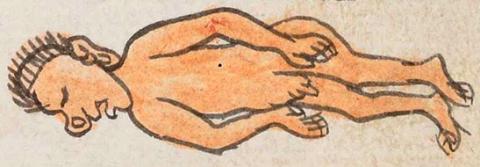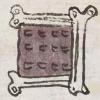Miquetlan (Mdz12r)
This is a simplex glyph for a place name in what is now the state of Veracruz, Miquetlan or Miquiyetlan. The root of the word is the same as the visual, a deceased person (miquetl). This nude body (obviously male) is laid out straight and uncovered, unlike the bodies in some versions of Mictlan glyphs. The skin of this man is terracotta in color. The locative suffix (-tlan) is not shown visually.
Stephanie Wood
As Miquiyetlan or Miquetlan, this place name appears to have one or two syllables more than the similar place name in the state of Oaxaca (Mictlan, today Mitla). This is puzzling, because the meaning appears to be the same—"Where the Dead Are"—and the phonetics should be the same, too. [See: Gordon Whittaker, "The Study of North-American Place Signs," Indiana 13 (1993), 20.] Both micqui and miquetl are nouns that can refer to corpses; perhaps one is more popular in one region than another. Perhaps this version represents an influence from Huaxtec Nahuatl. The body is laid out straight in this glyph, in contrast to some representations of Mictlan that involve a seated, shrouded body. This body is obviously male (as is the posture of the shrouded corpses), but this person might not be of the same social status. The hairstyle and the ear adornment may suggest an ethnic reading associated with a particular region, such as the Huasteca (in Spanish). Another body—of a thief who was stoned to death—that also appears in the Codex Mendoza does not have this particular hairdo or earplug.
Stephanie Wood
miquetlan-- puo
Miquetlan, pueblo
Stephanie Wood
c. 1541, or by 1553 at the latest
Stephanie Wood
Miqueyetlan, euphony, eufonía, death, la muerte, muertos, nombres de lugares

mique(tl), a deceased person, https://nahuatl.wired-humanities.org/content/miquetl
mictlan, place of the dead, https://nahuatl.wired-humanities.org/content/mictlan
-tlan (locative suffix), https://nahuatl.wired-humanities.org/content/tlan
"Where They Have Corpses" [Frances Karttunen, unpublished manuscript, used here with her permission.]
"Where There Are Many Corpses" (Berdan and Anawalt, 1992, vol. 1, p. 192)
"Donde Tienen Cadáveres"
Stephanie Wood
Codex Mendoza, folio 12 recto, https://digital.bodleian.ox.ac.uk/objects/2fea788e-2aa2-4f08-b6d9-648c00..., image 34 of 188.
The Bodleian Libraries, University of Oxford, hold the original manuscript, the MS. Arch. Selden. A. 1. This image is published here under the UK Creative Commons, “Attribution-NonCommercial-ShareAlike 3.0 License” (CC-BY-NC-SA 3.0).




